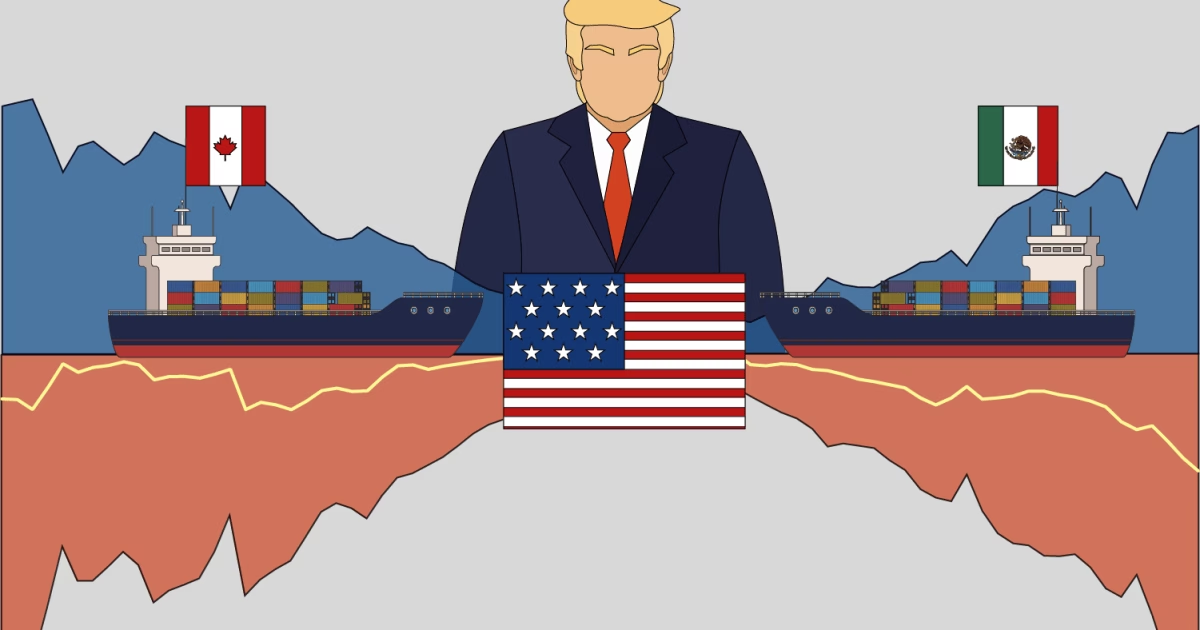US President Donald Trump has implemented immense 25 percent tariffs on products imported from Mexico and Canada.
These tariffs, effective at 00:00 Eastern Time (05:00 GMT) have led to abrupt falls in global markets.
Additionally, Washington has slapped an extra 10 percent levy on goods from China, on top of the 10 percent imposed the previous month.
Mexico and Canada are the US’s top trading partners, together accounting for more than 30 percent of the US’s total goods trade, with the trade value among the three nations surpassing $1.6 trillion.
Tariffs will apply to imports from Mexico and Canada amounting to almost $918bn.
How did this come about?
The tariffs on Mexico and Canada were among the first measures proposed after Trump’s re-election in November. He claims they are aimed at pressuring Mexico and Canada to curb immigration and drug trafficking into the US and to balance the trade deficit.
In early February 2025, Mexican President Claudia Sheinbaum and Canadian Prime Minister Justin Trudeau reached accords to bolster border security in a bid to curb drug trafficking and migration into the US, in last-ditch efforts to delay tariffs that were set to kick in on February 4, 2025.
Last month, Trump also announced plans for 25 percent tariffs on aluminum and steel imports, set to take effect on March 12, which will also affect Mexico and Canada.
What are tariffs and how do they operate?
A tariff is a tax imposed by the government on goods and services imported into the country, collected from businesses that import those products.
Tariffs are designed to safeguard domestic industries by increasing the cost of foreign products, which could reduce their demand and therefore protect the domestic market.
When Trump’s first administration introduced tariffs in 2018, the intention was to bolster US industries and penalize foreign exporters. However, American businesses and consumers bore the brunt of these measures.
The 25 percent tariffs on Mexican and Canadian exports could increase costs, curtail trade, lead to job losses, foster economic uncertainty and trigger retaliatory measures, escalating a potential trade war.

What is the US-Canada and US-Mexico trade deficit?
The US is facing a trade deficit with both Canada and Mexico, meaning that the volume of goods it buys from these countries outstrips the volume of goods it sells to them.
Trump argued in a White House statement on February 1 that tariffs are a powerful bargaining chip for the US, highlighting that trade accounts for 67 percent of Canada’s gross domestic product (GDP) and 73 percent of Mexico’s, compared to only 24 percent for the US. The US trade deficit in goods was the world’s largest at over $1 trillion.
Mexico stands as the US’s top trading partner. In 2024, the US imported $505.8bn in goods from Mexico and exported $334bn, leading to a trade deficit of $171.8bn.
Despite growing trade, the US has consistently registered a deficit with Mexico, which has enlarged over the past decade.

Canada is the second-largest US trading partner. In 2024, the US imported $412.7bn worth of goods from Canada and exported $349.4bn, resulting in a trade deficit of $63.3bn.

While tariffs might aim to cut trade deficits by reducing imports, their actual impact is more complex, with the potential for retaliatory measures and increased prices for consumers.
How will tariffs impact the United States-Mexico-Canada Agreement (USMCA)?
In 2018, during his first term, Trump introduced the USMCA to replace the North American Free Trade Agreement (NAFTA), which was established in 1992 under President George HW Bush’s tenure.
The USMCA, which took effect in 2020, aimed to modernize trade among the three nations, with provisions to strengthen labor and environmental protections, bolster car manufacturing requirements, expand digital trade rules and enhance intellectual property protection.
A review of the USMCA is scheduled for 2026, but the looming threat of tariffs could hasten these negotiations.

What Mexican products will be impacted by these tariffs?
Mexico is a major supplier of goods to the US, with vehicles, cars, and auto parts being the leading exports. Other key exports include machinery and electrical equipment, including computers and household appliances. Other significant exports are petroleum products, agricultural products, medical devices, plastics, and textiles.

According to the Observatory of Economic Complexity (OEC), Mexico’s main exports to the US in 2023 were:
- Vehicles and auto parts ($123bn): encompassing cars, buses, trucks, and automotive components
- Electrical machinery and electronics ($86.1bn): including computer equipment, telecommunications devices, and consumer electronics
- Machinery, mechanical appliances, and parts ($78.7bn): covering industrial machinery and equipment
- Mineral fuels and mineral oils ($25.2bn): including oil, refined oils, and petroleum gases
- Optical, photographic, technical, and medical apparatuses ($22.5bn): including medical and scientific instruments
- Furniture, bedding, and lighting ($13.3bn): including household and office furniture, bedding, and lighting fixtures
- Beverages, spirits, and vinegars ($11.6bn): including beer, spirits, and alcoholic beverages
- Fruit, nuts, and fruit peels ($9.38bn): such as tomatoes, avocados, and various fruits and vegetables
Which Canadian products will be impacted by these tariffs?
Canada is a major oil supplier to the US, with energy products, such as crude oil and petroleum products, comprising roughly 30 percent of all Canadian exports to the US. The second-largest exports are cars, tractors, and auto parts, followed by machinery and mechanical appliances. Other significant exports include medicines, plastics, and wood products.

According to the OEC, Canada’s main exports to the US in 2023 included:
- Energy products ($131bn): including oil, natural gas, and petroleum products
- Vehicles, tractors, trucks, and car parts ($56.7bn)
- Machinery and mechanical appliances ($32.2bn): including industrial machinery and equipment
- Plastics and plastic articles ($14.2bn)
- Wood and charcoal products ($11.5bn): including plywood, veneers, and sawn wood
- Electrical machinery and equipment ($10.2bn): including household appliances and electrical components
- Precious metals and stones ($9.87bn): including gold, silver, and diamonds





